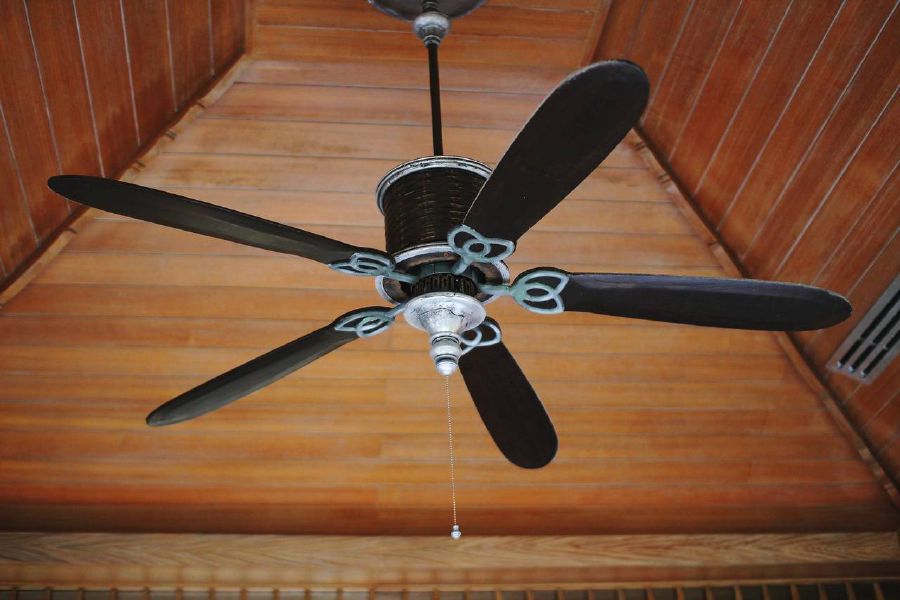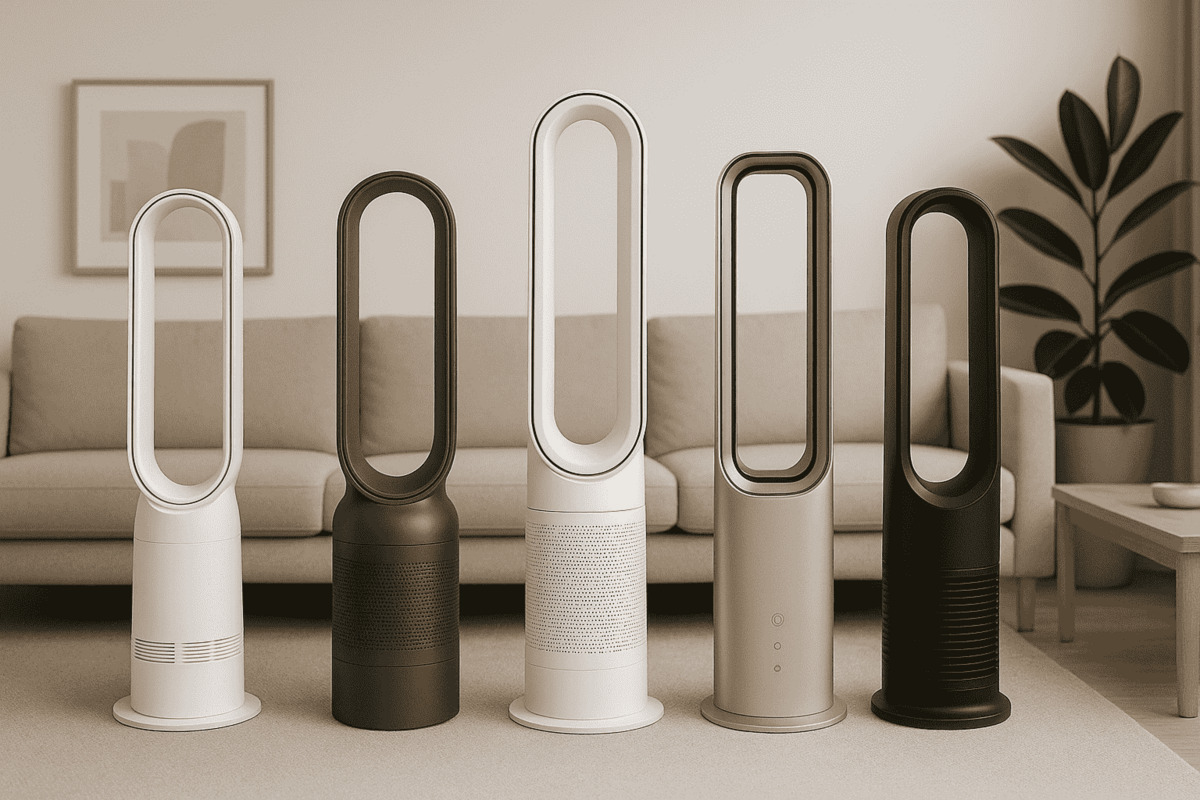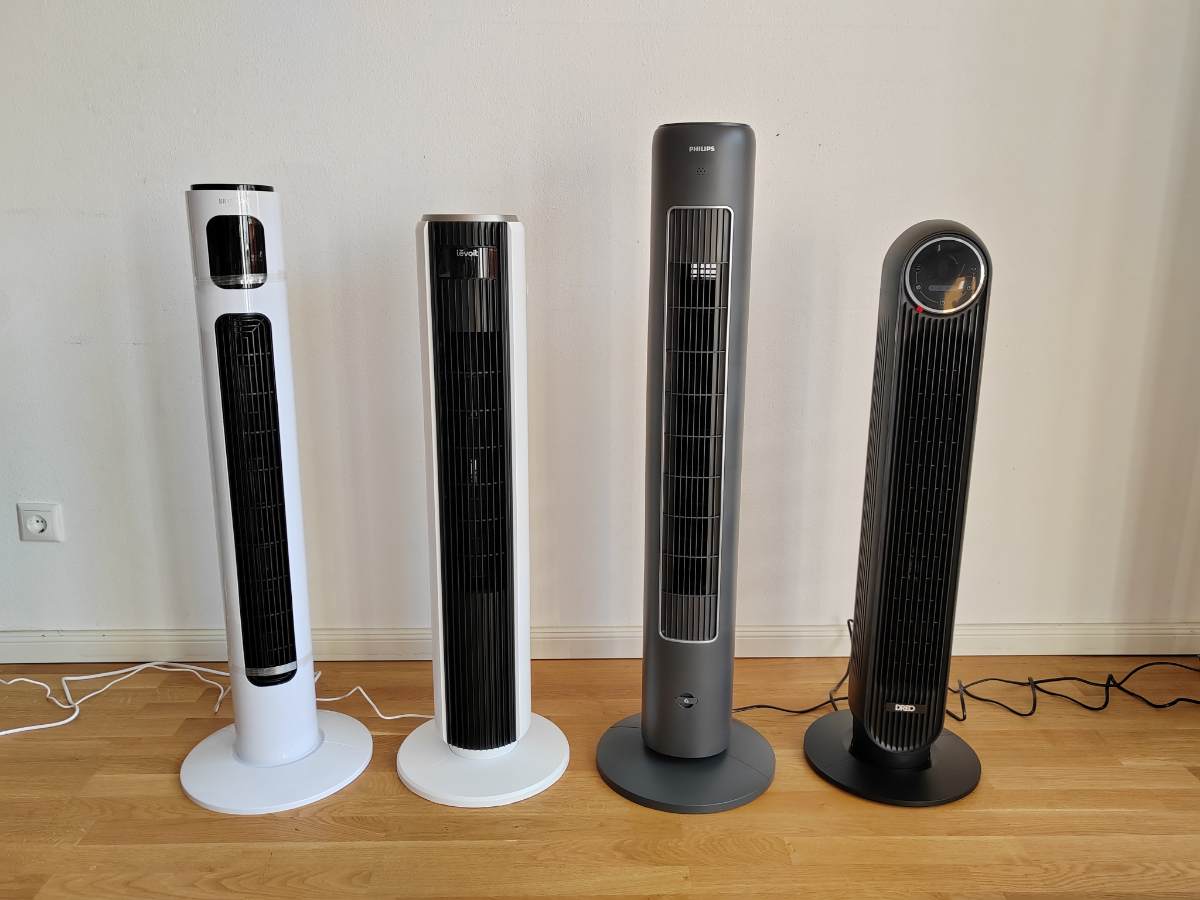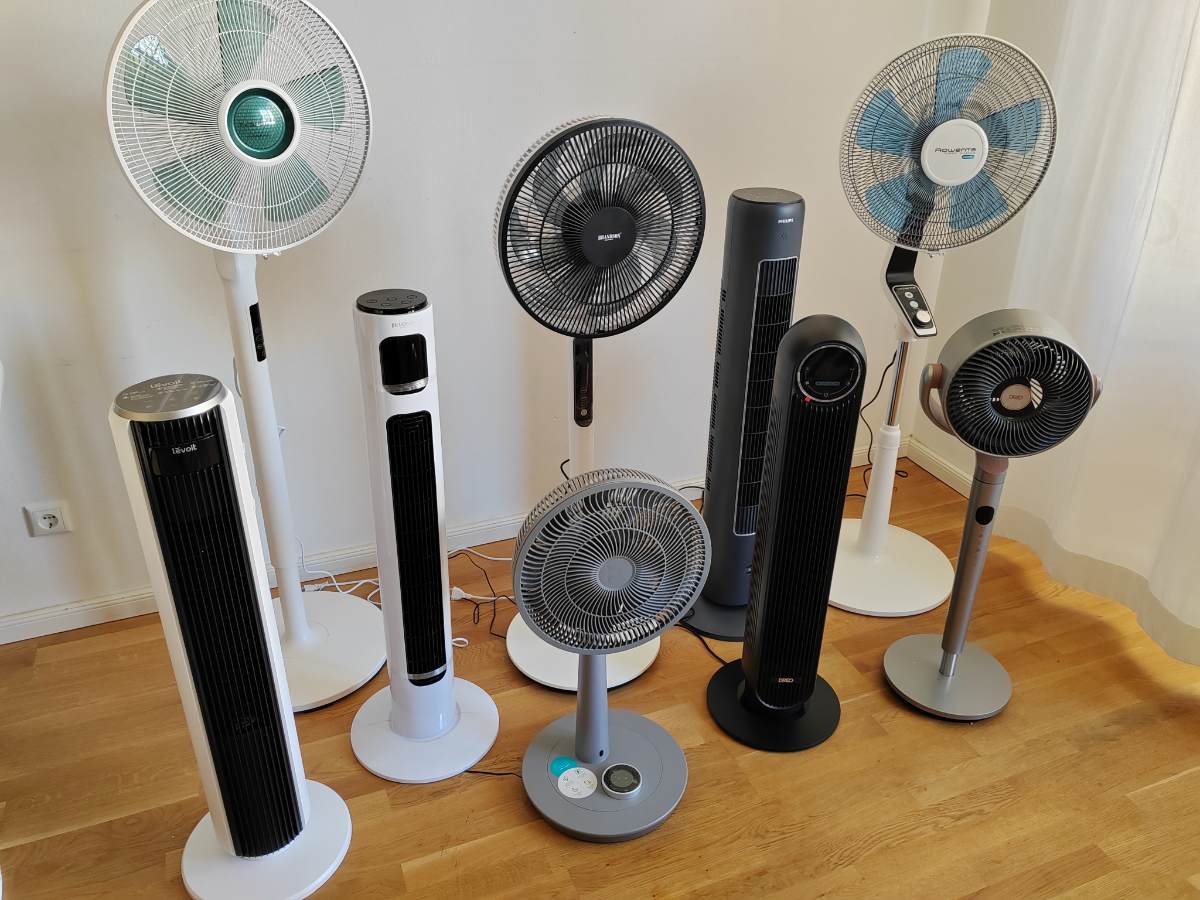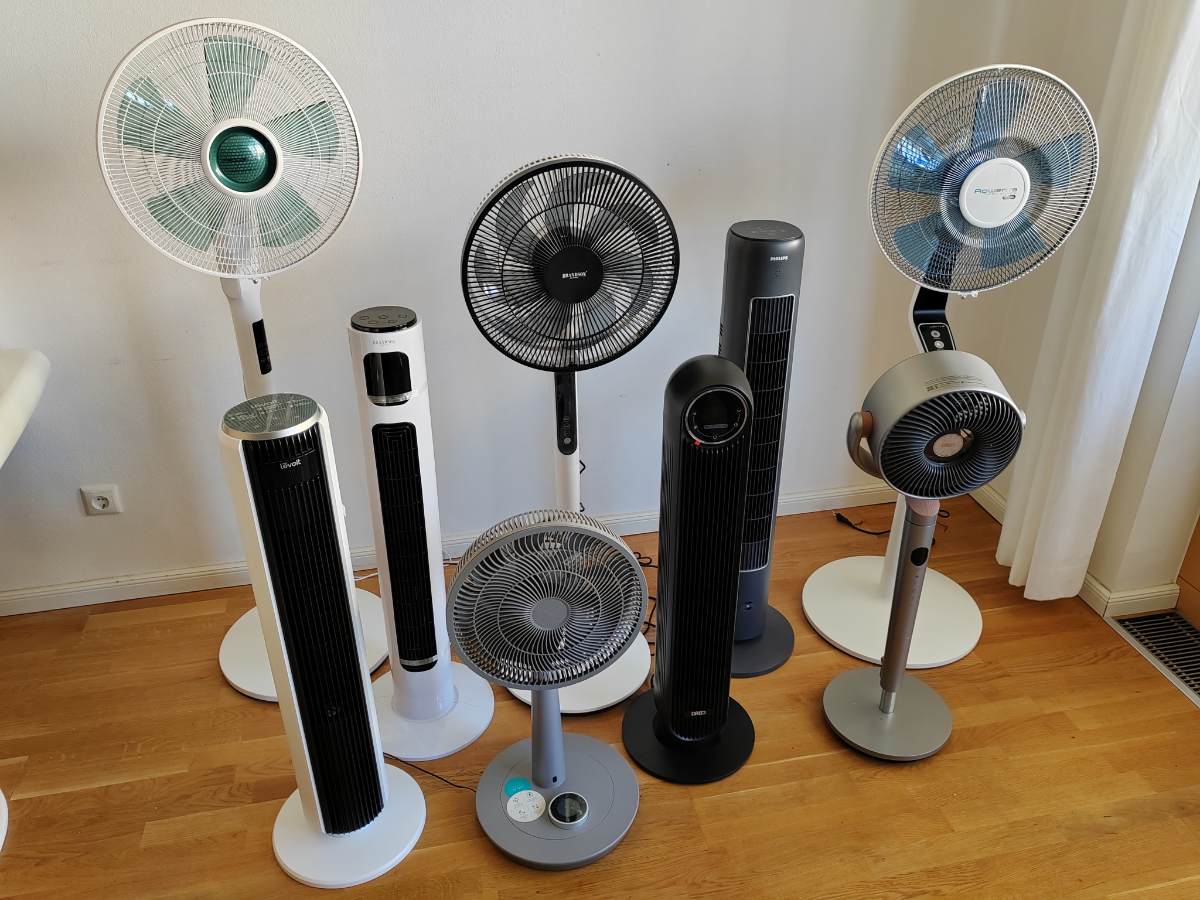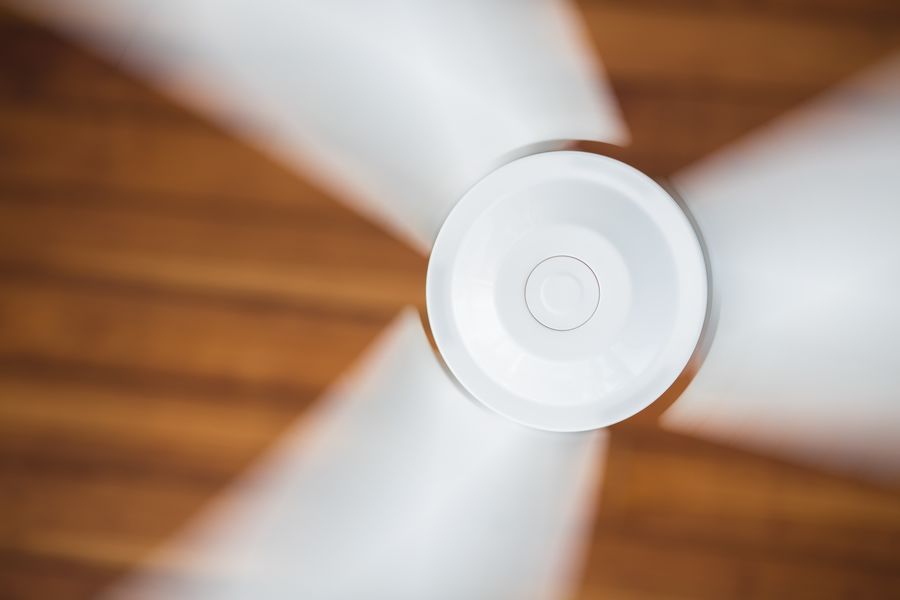Ceiling fans in comparison: These are recommended models!
Ceiling fans are not only beautiful to look at, they also have tangible practical benefits. They improve the indoor climate and can even help you save on heating costs.
A ceiling fan is one of the largest fans for interiors. As it is mounted on the ceiling, it takes up less usable space than a tower fan. The size and shape of the ceiling fan has several advantages:
- Large air flow even with slow rotation
- Quiet and therefore also suitable for the bedroom
- Ceiling fans can be fitted with light sources
Mounting on the ceiling is a disadvantage. The latter should have the necessary load-bearing capacity and a power connection must be available.
Models that also have a Integrated lamp are therefore doubly practical: they can be installed where there is a connection for a ceiling light. It replaces the ceiling light and, depending on the model, can be operated using the light switch. We take a look at 7 recommended ceiling fans that are worthwhile:
Which fan is right for me?
In the following list you will find four ceiling fans that I recommend.
The variants differ in form, function, performance and many other aspects. It is therefore not easy to categorise them in a specific ranking list.
It may well be that the first product in my list is not your first choice. Nevertheless, I hope that this list will give you a good overview of this product category.
CREATE / WINDCALM ceiling fan with LED light and natural wood wings
The CREATE WINDCALM ceiling fan is particularly impressive thanks to its combination of modern design, Quiet operation and functional equipment. The strikingly beautiful natural wood blades create a stylish look, while the stainless steel motor housing may appear somewhat larger and chunkier, but can still be elegantly integrated into many room styles.
A clear highlight is the Extremely quiet DC motor. At the low speed levels (1-2), the fan operates almost silently and is therefore ideal for bedrooms. Slight wind noise is only audible from speed 3, but the motor itself remains pleasantly quiet. At higher speeds (5-6), the air flow increases significantly, which is particularly pleasant at the height of summer, but then becomes audible.
The integrated LED lighting with Three selectable colour temperatures (warm, neutral, cold) provides good brightness for medium-sized rooms, but is not dimmable. Some users felt that the plastic cover of the light was not quite as high quality as the rest of the device, but functionally it fulfils its purpose.
In addition to Six speed levels also a Practical timer (1 to 4 hours)ideal for falling asleep. One point of criticism here: when the timer expires, the lighting sometimes switches on automatically, which was perceived as annoying, especially at night.
Assembly is quick and easy for experienced craftsmen. The enclosed Radio remote control works reliably and intuitively, even without direct visual contact with the device.
In the Winter mode the fan effectively distributes the warm air from the ceiling back into the room - a practical addition to the heating period.
Conclusion: The CREATE WINDCALM ceiling fan is a high-quality, quiet and powerful model with many practical functions and an attractive appearance. Despite minor weaknesses in the timer function and the lamp cover, the overall package is impressive, especially for living rooms and bedrooms up to approx. 25 m². A fan worth recommending with a good price-performance ratio.
Ovlaim 165CM walnut wood ceiling fans with lights
The design in a wood look with black contrast is modern and looks like a real home accessory thanks to its simple elegance. The workmanship is solid and the materials appear robust and of high quality.
The assembly is the only point that demanded a little patience from me. Unfortunately, the instructions are not very clearly structured, and some of the pictures and explanations are more likely to cause frowns than aha moments. The radio receiver and the wiring for the LED lighting in particular required a bit of fiddling around. However, once you have mastered the first part and attached the fan to the ceiling, the big "aha" moment comes: the function is convincing across the board!
The DC motor is really whisper-quiet - at the lower settings it is barely audible, which makes it ideal for the bedroom. Even at higher levels, the operating noise remains pleasant. The air flow is easy to regulate, with even the first level providing plenty of freshness. With its six speed levels and the option of left and right rotation, it is also well suited for heat distribution in winter.
I was also impressed by the light: with 3 colour temperatures (3000K, 4500K, 6000K) and the dimming function, it is not only practical, but can also be adjusted to create the right atmosphere. The 2400 lumens make the room pleasantly bright without dazzling.
The highlight is of course the smart control via app - it works perfectly. Alternatively, the fan can also be controlled via the remote control, which is very practical in everyday life. However, the beeping with every input is a little annoying - this can be particularly annoying at night.
The bottom line: A high-quality, powerful and visually appealing ceiling fan with light that is suitable for bedrooms as well as living rooms or patios. Only the installation requires a little time and patience.
Cyclone 132 cm ceiling fan - the classic
The Westinghouse Cyclone 78370 is a classic among ceiling fans - and this is evident as soon as you unpack it. The brushed steel look has a high-quality appearance, the five reversible blades can be fitted in black or with a silver stripe - so it blends in well with your own room concept.
Assembly is generally easy, especially when working in pairs. The instructions are illustrated and easy to understand. There is the option of installing the fan with or without the enclosed extension pole - so it can also be used well with low ceilings (height approx. 23 cm without extension).
The motor is pleasantly quiet overall, although a slight humming or grinding noise can occur depending on the model. Quality control seems to vary somewhat here. In several field reports, there was talk of fine adjustments or replacement devices - which, however, leads to a perfect result after a little patience.
In operation, the fan is particularly impressive in winter mode: it efficiently distributes the warm air from the ceiling back into the room, which saves heating costs. Summer mode is solid, although not everyone finds the air circulation at the highest level strong enough. However, it generally performs well in medium-sized to large rooms (up to 36 square metres).
A clear plus: the ability to retrofit a remote control. This makes control convenient and, according to reviews, works very reliably. Only switching between summer and winter mode has to be done directly on the appliance - a minor drawback.
All in all, the Cyclone 78370 is a robust, visually appealing ceiling fan with quiet operation and a practical reverse function. Minor weaknesses in air performance or manufacturing quality may need to be taken into account - but overall it is a solid device with proven technology.
Cayuga ceiling fan 152 cm
The Westinghouse Cayuga 72077 is a ceiling fan for larger rooms - with its impressive span of 152 cm and six stylish blades, it is not only a functional appliance, but also a real eye-catcher.
In terms of design, the Cayuga makes quite an impression: the reversible blades in rosewood or light-coloured maple provide visual flexibility, while the opal frosted glass of the light blends in elegantly. The fan is operated using the remote control supplied - with three speed settings and a separate light switch.
Installation is easy thanks to the illustrated instructions, although it helps to sort and think through the parts on the floor beforehand. As is often the case with ceiling fans, laying the cables is a little fiddly, but can be done with a little patience.
During operation, the Cayuga impresses with its quiet motor operation. At level 1 it is practically inaudible, from level 2 you can only hear the air noise - which also makes the fan suitable for bedrooms or living rooms. The air output is powerful and efficient, even larger rooms up to 25 square metres are well ventilated. The switchover function for summer and winter allows warm air to be distributed effectively in winter.
One disadvantage: The fan has a classic AC motor. This means it is less energy-efficient than comparable models with DC technology. It also lacks smart functions such as app control or Alexa integration. However, the fan can be retrofitted with a smart switch (e.g. Shelly).
On the light side, two E27 bulbs (not included) are used - positive: you can simply use LED bulbs of your choice, but there is no dimming function via the remote control supplied. The option with dimming function must be purchased separately.
Conclusion: The Cayuga is a stylish, powerful fan with solid technology and very quiet operation. If you can do without smart features and value classic, elegant design, this model is a good choice.
Westinghouse Lighting ceiling fan - Industrial with three wings
This industrial-style fan has no frills and there is little to complain about visually. It is equipped with 122 centimetres in diameter smaller than the previous "Cyclone" model. It is also equipped with 5.5kg around 800 grams lighter.
The weight plays a role in the installation and mounting. Before buying, check whether the ceiling to which you want to attach a ceiling fan has sufficient load-bearing capacity.
The three blades move less air per revolution than the "Cyclone" model, which has five blades. On the other hand, the three wing blades faster. The maximum number of revolutions per minute is 260, which is 80 revolutions more per minute than "Cyclone".
As a result of fewer rotor blades and faster rotation, however, it moves about the same amount of air per minute.
Note: More rotor blades ensure a stronger air flow as well as faster rotation. However, the fan should not have too many blades either.
In my eyes, this model is slightly superior to the previous one in terms of looks. However, it comes in second place because it has fewer rotor blades. It has to rotate faster to achieve the same airflow. Faster rotation generally results in more noise. In addition, a room looks a little restless when a ceiling fan is rotating at full speed.
In short: It is better to have more blades and slower rotation. Such fans are often quieter and provide comparable air circulation with fewer revolutions.
Westinghouse Lighting - 132 cm ceiling fan Bendan
The design of the "Bendan" ceiling fan is less industrial and more soft and rounded. I think the combination of wooden blades, metal and light-coloured frosted glass is quite successful.
With the Diameter of 132 centimetres Bendan" is also sufficient for rooms up to around 35 square metres. In terms of weight, this model is the heaviest on this list so far; overall, it weighs in at 7.6kg on the scales.
Behind the frosted glass is a socket for a R7s light source. Integrated lights are really practical for ceiling fans. After all, they need a power connection anyway and therefore occupy a ceiling connection that would otherwise have been fitted with a ceiling light.
This ceiling fan can also rotate clockwise and anti-clockwise. It is therefore suitable for Winter and summer operation suitable. With the associated Remote control can be used to control the fan and the integrated lamp.
One drawback of the appliance is that it comes with a halogen bulb that requires a whopping 80 watts. Although this produces a really bright light, it is not really energy-saving.
Another positive aspect is that this model, despite its integrated lamp, is only 36 centimetres high is. This means it measures far less in height than fans equipped with spotlights. Bendan" is a good option for rather low ceilings that still need a fan with lighting.
Westinghouse Lighting - Comet Tiffany
The "Comet Tiffany" is visually a little further away from the norm. The dark colour and the decorated lamp glass go well with dark-coloured furnishings. It would probably be less suitable in a light-coloured kitchen.
In terms of colour, this model offers the most harmonious overall picture for me. However, the design itself is rather unconventional and therefore certainly not everyone's cup of tea.
In keeping with the design, this ceiling fan comes with Pull switches instead of a remote control. There is one pull switch each for the fan and the light source attached to it.
If you wish, you can still order a Buy remote control.
With its 133 centimetres in diameter and the five blades, it ensures a good air flow. It is suitable for rooms up to around 35 square metres.
It also has a Winter and summer modeThe blades rotate clockwise and anti-clockwise respectively. In this way, the air circulation provides a refreshing breeze in summer and the heat from the radiators is better distributed in winter.
The Motor runs pleasantly quiet and has three speed settings.
With a Height of 38 centimetres it is a rather high model. Before buying, check whether the ceiling height provides enough space so that you don't accidentally bump into the fan.
Ceiling fan or pedestal fan?
The question is justified. Why wouldn't you prefer a pedestal fan? After all, tower, table and pedestal fans don't have to be mounted on the ceiling. They are simply placed where they are needed - that's it!
What are the advantages of a ceiling fan that make up for the hassle of installation? The answer to this question is a combination of features that a ceiling fan combines and which make it superior in some respects:
- No space is taken up on the floor
- Quieter motor; larger blades have to rotate more slowly for the same air circulation
- Summer and winter operation ensure a pleasant breeze in summer or better heat distribution in winter
- A ceiling fan can look very elegant, whereas table and tower fans rarely do
Another advantage is that the ceiling fan simply stays where it is. A pedestal fan is moved back and forth as required and that can be annoying. The fan on the ceiling is always available and Does not take up any useful spacewhen it is not switched on.
As indicated, models with a Winter and summer mode practical. They are not only useful in summer, but can even offer an advantage in winter. In summer, it is designed to push a flow of air towards the floor, which is perceived as a refreshing draught. In winter, on the other hand, it turns the other way round and pushes the air towards the ceiling. As a result, the air rising slowly from the radiators is better distributed in the room, which more efficient heating can be realised.
Disadvantages of the ceiling fan
As described the assembly the main disadvantage. It makes work and often requires a second pair of hands.
Not every room is suitable for installing a ceiling fan. If the Ceiling height too low, the appliance will interfere with the view across the room. In the worst case, the moving blades can even be dangerous if the appliance is hung too low.

It is also essential to check the weight of the model before buying. The ceiling should of course be able to bear the weight - and for a long time. In addition to the load-bearing capacity of the ceiling Suitable power connection required so that the fan can be operated at all. Fortunately, standard ceiling connections, which would otherwise be taken up by ceiling lights, are often sufficient.
What is surprisingly not a real disadvantage is the price. You can get a decent ceiling fan for €100-200. A tower or pedestal fan with comparable air circulation costs a similar amount if the quality and, above all, the volume are to be at the same level.
What should a good ceiling fan cost?
The price for a decent, permanently mounted - i.e. not portable - ceiling fan is over €100. Few models below that are really convincing. But you certainly don't have to spend a fortune. As I said, these are solid products between 100-200€ to have.
In return, you get fans that have several speed levels, wooden or metal blades, a summer/winter mode and can be controlled by remote control.
I think that covers the vast majority of needs. You can then choose to spend more money on additional functions, more sophisticated materials or an extraordinary design.
Ceiling fans with Smart Home
In my opinion, one of the most helpful additional functions is control via app. If you want to buy a new and larger appliance for your household now, then it's worth thinking about possible SmartHome functionalities.

There are some models that can be controlled with an app. And that is already a good thing, but it would be even better if the device could be Compatible with the common SmartHome platforms is. Then you are not at the mercy of the company to keep the app up to date, but can control the fan with Siri, Google Home or Alexa, for example.
These large SmartHome platforms have built-in functions that you can use to according to schedule or depending on other SmartHome devices in the house. This makes perfect sense with ceiling fans: depending on the time of day, season, temperature or the activity of radiators, for example.
Volume of a ceiling fan
The low noise level is one of the advantages of this product category. As they are equipped with relatively large blades, they do not have to rotate as quickly as a small table fan, for example.

Models with five blades instead of three or four generate greater air circulation at the same rotational speed. However, the sheer number of rotor blades is not the only decisive factor for the strength of the air flow. Rather, it is one of many factors. More blades do not always mean more power.
Rule of thumb: Fans with more blades are quieter as they have to rotate less quickly.
The slower rotation is the main reason why ceiling fans run pleasantly quietly. This is why they are often used in bedrooms or living rooms where a quiet atmosphere is desired.
If you don't want a ceiling fan after all, you could also use a special Quiet fans - for example, as a pedestal or tower fan - can be a good alternative. They provide pleasant cooling even in warmer temperatures without disturbing the peace and quiet.
